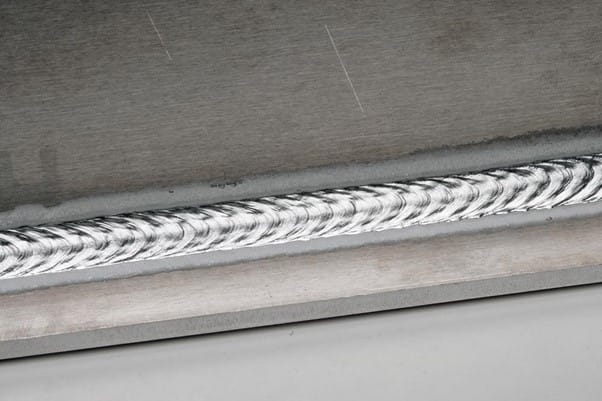Fundamentals of MIG Welding Aluminium with a Cobot
Metal Inert Gas (MIG) welding is one of the most versatile and widely used welding methods. When it comes to welding aluminium, the process can be particularly challenging due to the metal’s unique properties. However, the integration of collaborative robots (cobots) into the welding process has brought a new level of precision, consistency, and efficiency. This article will explore the fundamentals of MIG welding aluminium using a cobot, highlighting key considerations and best practices.

Understanding Aluminium’s Properties
Aluminium is a lightweight and corrosion-resistant metal, making it a popular choice in industries such as aerospace, automotive, and construction. However, its high thermal conductivity, low melting point, and oxide layer present challenges in welding. The oxide layer, for instance, melts at a much higher temperature than the aluminium itself, necessitating thorough cleaning before welding.
Additionally, aluminium’s high thermal conductivity can cause heat to dissipate quickly, requiring higher heat input to maintain a stable weld pool. This makes controlling the welding parameters critical to achieving high-quality welds.
The Role of Cobots in Aluminium Welding
Collaborative robots, or cobots, are designed to work alongside humans, offering precision and consistency in repetitive tasks such as welding. Cobots equipped with advanced welding systems provide numerous advantages in MIG welding aluminium:
- Consistency: Cobots ensure uniform welds by maintaining steady speed, angle, and distance throughout the welding process.
- Precision: Cobots can be programmed to follow complex welding paths with high accuracy, minimizing defects.
- Efficiency: Automating the welding process reduces downtime and increases productivity.
- Safety: Cobots take over hazardous tasks, reducing the risk of human exposure to welding fumes and heat.
Key Steps in MIG Welding Aluminium with a Cobot
- Preparation:
- Material Cleaning: Remove the oxide layer from the aluminium surface using a stainless-steel brush or a chemical cleaner. Ensure the material is free from grease, oil, and other contaminants.
- Wire Selection: Use an aluminium wire that matches the base material’s alloy. Common options include ER4043 and ER5356.
- Gas Selection: Use pure argon or a mixture of argon with helium to create a stable arc and minimize spatter.
- Cobot Programming:
- Path Planning: Define the welding path using the cobot’s programming interface. Cobots often feature intuitive programming methods, such as hand-guiding or graphical interfaces. A3L offer the Smooth Robotics, SmoothTool programming interface, a world leading cobot programming system.
- Parameter Settings: Set appropriate parameters, including wire feed speed, voltage, and travel speed. For aluminium, these settings are typically higher than for steel due to its high thermal conductivity.
- Torch Angling: Position the MIG torch at a push angle (10-15 degrees) relative to the direction of travel. This helps maintain a stable arc and clean weld pool.
- Welding Execution:
- Ensure the cobot is calibrated correctly to maintain consistent distance between the torch and the workpiece.
- Monitor the weld quality during initial passes to make adjustments if necessary.
- Post-Welding Inspection:
- Inspect the welds for defects such as porosity, cracks, or lack of fusion.
- Perform any necessary post-weld cleaning, such as removing slag or spatter.
Overcoming Common Challenges
- Porosity: Porosity can occur if the shielding gas flow is inadequate or if contaminants are present on the aluminium surface. Ensure proper cleaning and consistent gas flow.
- Burn-Through: Aluminium’s low melting point can lead to burn-through. Use pulsed MIG welding to control heat input effectively. At A3L we recommend the Kemppi Master M power sources with it’s pulse capability.
- Inconsistent Welds: Regularly inspect and maintain the cobot’s components, such as the welding torch and wire feed system, to ensure consistent performance.
Conclusion
MIG welding aluminium with a cobot combines the precision of automation with the flexibility of human oversight. By understanding aluminium’s unique properties and leveraging the capabilities of cobots, manufacturers can achieve high-quality welds efficiently and safely. Proper preparation, programming, and process monitoring are essential to overcoming the challenges of aluminium welding and fully realizing the benefits of cobot integration.
Contact A3L today for more information on aluminium welding with a cobot and to book an onsite demonstration.
Related posts
Understanding Pulse MIG Welding: An Innovative Welding Technique
Pulse Metal Inert Gas (MIG) welding is a cutting-edge welding process that offers significant advant
Automated Welding with Cobots: Revolutionizing Fabrication for SMEs
In the fast-evolving world of manufacturing and fabrication, Small and Medium-sized Enterprises (SME
How Cobot Welding Can Propel Your Business Forward
Understanding Cobot Welding Cobot welding significantly simplifies the welding process compared to t